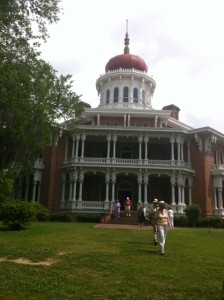
Longwood, an unfinished mansion in Natchez that’s the largest octagonal house in America. Photo by Clark Norton.
I’d like to be able to convince you that the life of a travel writer aboard a cruise ship sailing down the Mississippi for a week was one of arduous labor, a dawn-to-midnight whirl of interviews, note-taking, picture-making, fervid sightseeing, cabin inspections, food critiques, and long hours spent at the computer chronicling it all.
And yes, that does describe many cruises I’ve taken professionally. But on this cruise, American Cruise Lines’ Queen of the Mississippi voyage down the lower Mississippi from Memphis to New Orleans, I took a different tack. I relaxed and enjoyed myself much as if I weren’t working at all.
Maybe it was being in the South, where the pace of life seems a little slower than in New York. Maybe it was the languid heat that proved such a contrast to the still-chilly New York spring (in late May!). Or maybe I was just having too good a time soaking in the atmosphere of being on an authentic (though new) paddlewheeler rolling down the river, relishing my time on deck or at my private balcony, taking in the scenery and watching the world go by, often watching the sunrise with coffee in hand.
Or maybe it was those huge breakfasts (waffles, omelets, biscuits and gravy, etc.), the three-course lunches (lobster salad, pulled pork sandwich, cherry pie or ice cream, or both), the drinks and munchies at cocktail hour, and the three-course dinners (crabmeat ravigote, Cajun spiced black Angus strip loin, peach and blackberry cobbler) with free-flowing wine that made me so mellow that my table mates noticed I was not jotting down their every bon mot.
Of course, there were also interesting shore excursions to take, not to be missed, which required getting off the boat. I tried to make preparation minimal: pack up smartphone, small camera, sunblock, bottled water, notebook, pens, and, on some days, raingear and umbrella — then handed the whole bag to my wife, Catharine. (Just kidding…kind of.)
After leaving Vicksburg, Mississippi, early on the afternoon of Memorial Day, we arrived in Natchez, Mississippi, that evening. We would be docked in Natchez all the next day, which was good because it proved to be the quintessential southern town, filled with impressive antebellum mansions and boasting a very nice walkway overlooking the Mississippi River.

A riverboat casino docked in Natchez, Mississippi. Photo from VisitNatchez.org.
At one time, in pre-Civil War days, Natchez was one of the richest cities in the world, with two-thirds of the nation’s millionaires living between here and New Orleans — all built on cotton plantations fueled by slave labor. It’s still considered the “crown jewel” of southwest Mississippi.
Like Vicksburg, Natchez is largely situated atop a bluff, a necessity when bordering a river that has been known to flood mightily (in 1927, a flood broke many of the levees along the river and caused widespread devastation).
However, there is an area right by the river called Natchez Under-the-Hill, where Natchez began and which had a reputation as a hangout for scoundrels back in the day. Now there are a couple of casinos based on riverboats that are moored permanently along the shore, as are all Mississippi casinos (allowing them to meet state regulations).
On our guided bus tour of the city, a complimentary shore excursion that drew most everyone on board and filled several buses, we swung through Natchez Under-the-Hill before seeing the downtown area and passing a number of historic antebellum homes, each seemingly more grand than the last. Some are now museums, including our main stop on the tour, Longwood, which stands out in several ways.
Longwood, the largest octagonal house in America, designed in the “Oriental Villa” style that gained some popularity in the mid-19th century, was started at a very inopportune time: 1860, right before the outbreak of the Civil War. Cotton planter Haller Nutt had made a fortune from his plantations, and built the six-story octagonal home with a Byzantine-Moorish dome, intended to outshine any other mansion in town.
But after finishing the basement level, the Civil War interrupted construction, and none of the other five floors was ever completed, except for the exteriors. Nutt died in 1864, and his family continued living on the basement level until his wife, Julia, died 33 years later. A local garden club now maintains the home as a museum just as it was when the family left it, including many of the original furnishings.
In the afternoon, Catharine and I explored Natchez on foot, getting a chance to walk along the paved path overlooking the river and passing by more historic homes.
We also resolved to return to drive the Natchez Trace Parkway, which runs some 444 miles from Natchez north to Nashville, passing through much of Mississippi and a corner of Alabama before reaching Tennessee.
Originally a trail forged by Native Americans, it later became popular with farmers and ranchers who transported crops and livestock down the Mississippi on flatboats for sale in Natchez or New Orleans, then sold their boats in Natchez and walked or rode horses back home along the Trace. Eventually, inns began to house and feed the travelers along the trail, and today a parkway parallels the old route. You can stop to hike, picnic or visit historic sites at many places along the way.
But for now, we were quite content to re-board the Queen of the Mississippi and continue our voyage downriver. Next stop: St. Francisville, Louisiana.












Leave a Reply